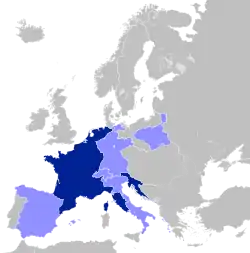Kingdom of Etruria
The Kingdom of Etruria (/ɪˈtrʊəriə/ ih-TROOR-ee-ə; Italian: Regno di Etruria) was an Italian kingdom between 1801 and 1807 that made up a large part of modern Tuscany. It took its name from Etruria, the old Roman name for the land of the Etruscans.[1]
Kingdom of Etruria | |||||||||||
|---|---|---|---|---|---|---|---|---|---|---|---|
| 1801–1807 | |||||||||||
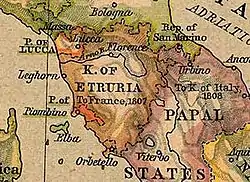 | |||||||||||
| Status | Client state of the French Empire | ||||||||||
| Capital | Florence | ||||||||||
| Common languages | Italian | ||||||||||
| Religion | Christian (Roman Catholic) | ||||||||||
| Government | Monarchy | ||||||||||
| King | |||||||||||
• 1801–1803 | Louis I | ||||||||||
• 1803–1807 | Louis II | ||||||||||
| Regent | |||||||||||
• 1803–1807 | Maria Luisa | ||||||||||
| Historical era | Napoleonic Wars | ||||||||||
| March 21, 1801 | |||||||||||
| December 10, 1807 | |||||||||||
| Currency | Tuscan pound | ||||||||||
| |||||||||||
History
The kingdom was created by the Treaty of Aranjuez, signed at Aranjuez, Spain on 21 March 1801. In the context of a larger agreement between Napoleonic France and Spain, the Bourbons of Parma were compensated for the loss of their territory in northern Italy (which had been occupied by French troops since 1796). The King of Spain decided that his cousin Ferdinand, Duke of Parma had to cede his duchy to France, and in return his son Louis I was granted the Kingdom of Etruria (which was created from the Grand Duchy of Tuscany). Shortly after Ferdinand refused to leave, he suddenly died in suspect circumstances. To make way for the Bourbons, the Habsburg Grand Duke of Tuscany Ferdinand III was ousted and compensated with the Electorate of Salzburg by the Treaty of Lunéville.[2]
Outside the Treaty of Aranjuez, Spain also secretly agreed to retrocede the Louisiana territory (over 2 million square kilometers) back to France in order to secure the Kingdom of Etruria as a client state for Spain; Louisiana was first ceded by France to Spain in 1763 at the end of the Seven Years' War. Louisiana was duly transferred to France on 15 October 1802, after the signing of the Treaty of Aranjuez. Napoleon subsequently sold Louisiana to the United States in the Louisiana Purchase on April 30, 1803, in order to pay for his French armies during the War of the Third Coalition.
The first king (Louis I) died young in 1803, and his underage son Charles Louis succeeded him. His mother, Maria Luisa of Spain, was appointed regent. However, since Etruria was troubled with smuggling and espionage, Napoleon annexed the territory, thus it was the last non-Bonaparte Italian kingdom on the Peninsula to be absorbed into the French Empire. Since Spain's only hope of compensation lay in Portugal, co-operation with the emperor became more important.[2]
In 1807, Napoleon dissolved the kingdom and integrated it into France, turning it into three French départements: Arno, Méditerranée and Ombrone. The king and his mother were promised the throne of a new Kingdom of Northern Lusitania (in northern Portugal), but this plan was never realized due to the break between Napoleon and the Spanish Bourbons in 1808. After his downfall in 1814, Tuscany was restored to its Habsburg grand dukes. In 1815, the Duchy of Lucca was carved out of Tuscany, on the lands of the former Republic of Lucca, as compensation for the Bourbons of Parma until they resumed their rule in 1847.[3] As stipulated in the Treaty of Paris of 1817, in execution of the art. 99 of the Final Act of the Congress of Vienna, the Duchy of Lucca was then annexed by the Grand Duchy of Tuscany.[4]
Flags and coats of arms
- Flags
 State flag with the greater coat of arms
State flag with the greater coat of arms State flag with the lesser coat of arms
State flag with the lesser coat of arms.svg.png.webp) Merchant flag with the lesser coat of arms
Merchant flag with the lesser coat of arms.svg.png.webp) Merchant flag (used by little tonnage ships)
Merchant flag (used by little tonnage ships)
- Coat of arms
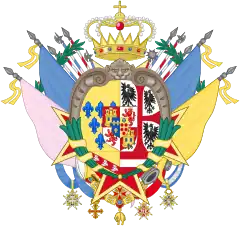 Greater coat of arms
Greater coat of arms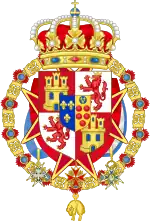 Middle coat of arms
Middle coat of arms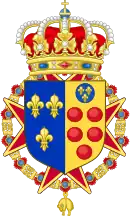 Lesser coat of arms
Lesser coat of arms
References
- Norman Davies, Vanished Kingdoms: The History of Half-Forgotten Europe, Penguin, 2012, chapter 10, “Etruria: French Snake in the Tuscan Grass,(1801-1814)”.
- Charles Esdaile (14 June 2003). The Peninsular War: A New History. Palgrave Macmillan. p. 7. ISBN 978-1-4039-6231-7. Retrieved 28 March 2013.
- "Article 101". Atto finale del Congresso di Vienna fra le cinque grandi potenze, Austria, Francia, Inghilterra, Prussia e Russia del 9 giugno 1815 (in Italian). Milan: Sanvito. 1859. p. 61.
- Atto Finale 1859, p. 77, Article 3 of the Treaty concluded in Paris on 10 June 1817 about the reversion of the Duchies of Parma, Piacenza e Guastalla.
Works cited
- Atto finale del Congresso di Vienna fra le cinque grandi potenze, Austria, Francia, Inghilterra, Prussia e Russia del 9 giugno 1815 (in Italian). Milan: Sanvito. 1859.
